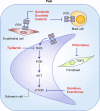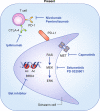Translating current basic research into future therapies for neurofibromatosis type 1
- PMID: 32439933
- PMCID: PMC7374719
- DOI: 10.1038/s41416-020-0903-x
Translating current basic research into future therapies for neurofibromatosis type 1
Abstract
Neurofibromatosis type 1 (NF1) is a hereditary tumour syndrome that predisposes to benign and malignant tumours originating from neural crest cells. Biallelic inactivation of the tumour-suppressor gene NF1 in glial cells in the skin, along a nerve plexus or in the brain results in the development of benign tumours: cutaneous neurofibroma, plexiform neurofibroma and glioma, respectively. Despite more than 40 years of research, only one medication was recently approved for treatment of plexiform neurofibroma and no drugs have been specifically approved for the management of other tumours. Work carried out over the past several years indicates that inhibiting different cellular signalling pathways (such as Hippo, Janus kinase/signal transducer and activator of transcription, mitogen-activated protein kinase and those mediated by sex hormones) in tumour cells or targeting cells in the microenvironment (nerve cells, macrophages, mast cells and T cells) might benefit NF1 patients. In this review, we outline previous strategies aimed at targeting these signalling pathways or cells in the microenvironment, agents that are currently in clinical trials, and the latest advances in basic research that could culminate in the development of novel therapeutics for patients with NF1.
Conflict of interest statement
The authors declare no competing interests.
Figures



References
-
- Friedman, J. M. Neurofibromatosis 1. in GeneReviews((R)) (eds Adam, M. P., Ardinger, H. H., Pagon, R. A., Wallace, S. E., Bean, L. J. H., Stephens, K. et al.). (University of Washington Seattle, 1993). - PubMed
-
- Klar N, Cohen B, Lin DDM. Neurocutaneous syndromes. Handb. Clin. Neurol. 2016;135:565–589.. - PubMed
-
- Hirbe AC, Gutmann DH. Neurofibromatosis type 1: a multidisciplinary approach to care. Lancet Neurol. 2014;13:834–843. - PubMed
Publication types
MeSH terms
Substances
Grants and funding
LinkOut - more resources
Full Text Sources
Research Materials
Miscellaneous

